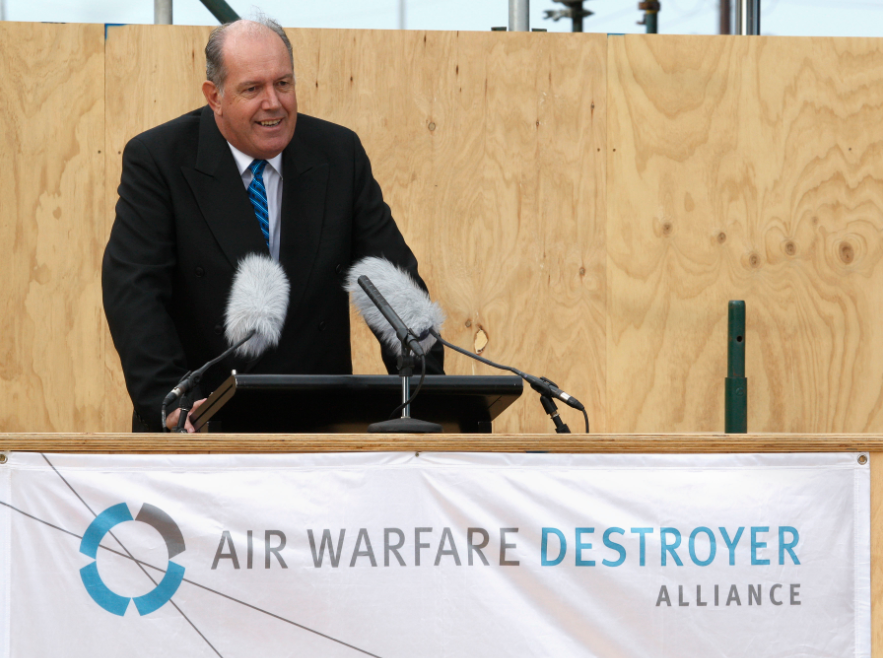It’s Australia’s biggest current defence project and a multi-billion dollar headache for Defence Minister David Johnston. The Abbott Government is expected to commission soon a broad scale external review of the $8 billion air warfare destroyer project as concerns grow within the government about cost-blowouts and schedule delays.
The first of the three AWD’s, HMAS Hobart, was originally due to be handed over to the RAN later this year but the delivery schedule has since twice slipped and the Hobart handover is now due in early 2016 with the final vessel, HMAS Sydney, to be completed in 2019. An even bigger concern, according to senior defence sources, is that the AWD project has spent the lion’s share of budgeted funds well before the delivery of single hull, putting the project’s remaining contingency reserve at risk.
Estimates of the projected AWD project cost blowout are now well north of half a billion dollars and counting. An ANAO report, believed to be strongly critical of the management of key aspects of the $8 billion project, is due to be published next month but its findings have been challenged by the DMO and Defence.
The Minister is now considering the appointment of an independent, possibly US-based defence expert, to head up the review team. The review, which will also cover financial aspects of the project, will report back to the Defence Minister within six months on ways to get the AWD project back on track and ensure a successful completion of the three air warfare destroyers.
How the Minister manages the unfolding AWD saga will have a vital bearing on the future of naval shipbuilding in Australia, with the government due to make major decisions on the next generation submarine build as well as future surface warship construction including the follow-on frigates to replace the ANZAC-class vessels.
A successful AWD build is a prerequisite for any sign-off by the Abbott Government on the local construction of a replacement for the Collins class submarines. It’s nearly seven years since the contract was signed for the construction of three AWDs by three shipbuilders around the country, with final assembly at ASC’s shipyard in Adelaide.
The AWD Alliance was established to manage the project. A wholly novel arrangement in the context of Australian naval shipbuilding, the AWD alliance was always destined to be a high-risk gamble for the government. It wasn’t just the modular construction technique adopted with three separate facilities building the 31 individual steel blocks that make up a complete hull. The heart of the AWD project’s financial and schedule problems stem from the nature of the alliance contract established to manage the warship contract. The AWD alliance brought together an unlikely trio of partners to manage the construction of the most complex and sophisticated warship ever built in Australia.
With Adelaide-based and wholly-government owned ASC chosen as the preferred shipbuilder, the Defence Department decided to bring in the Defence Materiel Organisation (DMO) and Raytheon Australia as the other two alliance partners. None of the partners had ever built a surface warship and the choice of Raytheon as an alliance partner was unusual given that its main commercial rival as a combat systems builder was Lockheed Martin, the supplier of the Aegis weapons system for the AWDs. ASC’s only track record was as the builder of the Collins class submarines and the government-run company’s board has always lacked a core of experienced naval shipbuilders.
Adapting the Spanish-designed F-100 ship for local construction in Australia would have been a difficult task even for an experienced naval shipbuilder such as Williamstown-based BAE Systems (formerly Tenix), which built the ANZAC frigates. And so it has proved, as Australian yards grappled with the drawings and construction practices furnished for the hull modules by Spanish shipbuilder and AWD sub-contractor Navantia.
Add to this the blurred lines of management responsibility through the alliance structure and the singular lack of naval-shipbuilding experience amongst the three partners, and it’s not surprising that the AWD project has run into difficulties. HMAS Hobart is now more than 80% complete, with some of its key systems already installed, but major challenges still lie ahead with the installation of the Aegis combat system now in store in Adelaide.
The Minister knows that the history of government-run naval shipbuilders in Australia hasn’t been a happy one. Thirty years ago the Williamstown Naval Dockyard, charged with building two FFG-class frigates for the RAN, was notorious for cost overruns and schedule delays. Delivered into private ownership and under new management, the dockyard completed the FFGs and evolved into a highly successful builder of the ANZAC frigates.
With hindsight, the AWD project would’ve benefitted from having a single prime contractor charged with the authority to manage and deliver the warships.
Any external review will need to examine forensically the three-ship build and identify exactly how cost and schedule blowouts have occurred.
Down the track as he moves to define the next generation of naval platforms Johnston will also have to determine the future of ASC. Earlier last decade the Howard government ducked away from privatising the company. If the next generation of submarines is to be built in Australia, then the Abbott government should move to sell ASC—preferably to a strong industry consortium willing to make a strategic investment in Australian defence industry. At stake is the whole future of naval shipbuilding in Australia.
Patrick Walters writes regularly for The Strategist.


